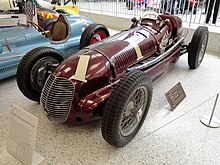|
Wilbur Shaw
Warren Wilbur Shaw (October 31, 1902 – October 30, 1954) was an American racing driver. The second three-time winner of the Indianapolis 500 (1937, 1939 and 1940), he is also remembered for serving as president of the Indianapolis Motor Speedway from 1945 until his death in 1954. Early lifeShaw was born in Shelbyville, Indiana on October 31, 1902.[1] Racing career Shaw first participated in the 1927 Indianapolis 500. He eventually won the Indianapolis 500 race three times, in 1937, 1939, and 1940.[2] Shaw was the second person to win the 500 three times, and the first to win it twice in a row.[1] In 1939 and 1940, he won driving a Maserati 8CTF named the 'Boyle Special.'[3] In the 1941 race, Shaw was injured when his car crashed; it was later discovered that a defective wheel had been placed on his car. Indianapolis Motor Speedway PresidentDuring World War II, Shaw was hired by the tire manufacturer Firestone Tire and Rubber Company to test a synthetic rubber automobile tire at the Indianapolis Motor Speedway (IMS), which had been closed due to the war. He was dismayed at the dilapidated condition of the racetrack and quickly contacted then-owner Eddie Rickenbacker, the World War I flying ace and president and founder of Eastern Air Lines. When the United States entered World War II, ending racing at Indianapolis and elsewhere for the duration, Rickenbacker padlocked the gates, and the race course slowly begin to disintegrate. During a meeting soon after the test, Rickenbacker informed Shaw that what was left of the track would be demolished and the land turned into a housing subdivision. Shaw sent out letters to the major car manufacturers trying to find a backer to buy the speedway. However, all indicated that should they buy the IMS they would turn it into a private testing facility for their own cars only. Shaw then met Terre Haute businessman Tony Hulman who had inherited his family's business, Hulman & Company, a wholesale grocer and producer of coffee and baking powder, Clabber Girl. A lifelong fan of automobile racing in general and the "500" in particular, Hulman listened with great interest to what Shaw had to say. Despite what Hulman saw amongst the weeds and deterioration when Shaw took him to Indianapolis, he purchased the Speedway from Rickenbacker in November 1945 for the sum of $750,000.[2] As a reward for his efforts to revive the Speedway, Shaw was appointed as its president, where he would have complete day-to-day control over the track. To this job, Shaw brought his extensive knowledge of the business of auto racing, something Hulman would admit that he himself didn't have, and Shaw's hard work only cemented the reputation of the "500" as the "Greatest Spectacle in Racing." It seemed as though Shaw and Hulman had a "Midas touch" at the Speedway. Hulman poured money into improvements, and Shaw delivered the world's greatest automobile race to enthusiastic crowds, which grew in number by the year. The Indianapolis "500" of the late Forties and early Fifties was a very special event through the work of Hulman and Shaw, although Hulman was always sure to point out that it was Wilbur putting it all together. DeathShaw was killed in an airplane crash near Decatur, Indiana, on October 30, 1954, one day before his fifty-second birthday. The pilot, Ray Grimes, and artist Ernest Roose were also killed.[1] Other work and legacyShaw was the automotive test evaluator for Popular Science magazine. As the automotive test evaluator, Shaw's articles were superior to those of his contemporaries in that they gave consistently accurate reports without relying on Popular Science's lead in the marketplace over competitors such as Mechanix Illustrated. Shaw's highly regarded autobiography, "Gentlemen, Start your Engines," was published in 1955, and covers events through 1953. As of 2024, he is the last Indiana native to win the Indianapolis 500. Awards and honorsShaw has been inducted into the following halls of fame:
Shaw has been awarded the following honors:
Motorsports career resultsIndianapolis 500 results
References
Further reading
External links
|
|||||||||||||||||||||||||||||||||||||||||||||||||||||||||||||||||||||||||||||||||||||||||||||||||||||||||||||||||||||||||||||||||||||||||||||||||||||||||||||||||||||||||||||||||||||||||||
